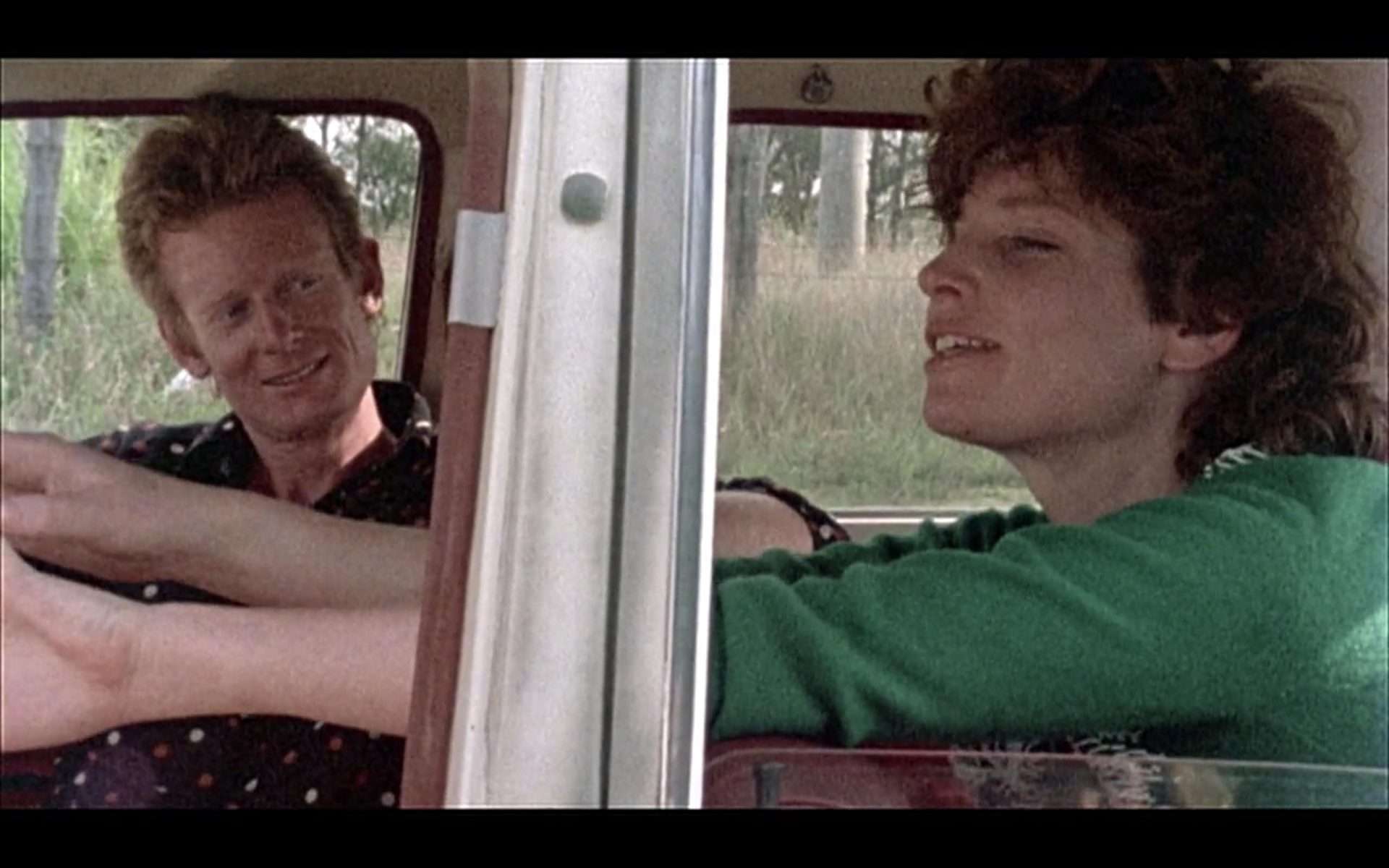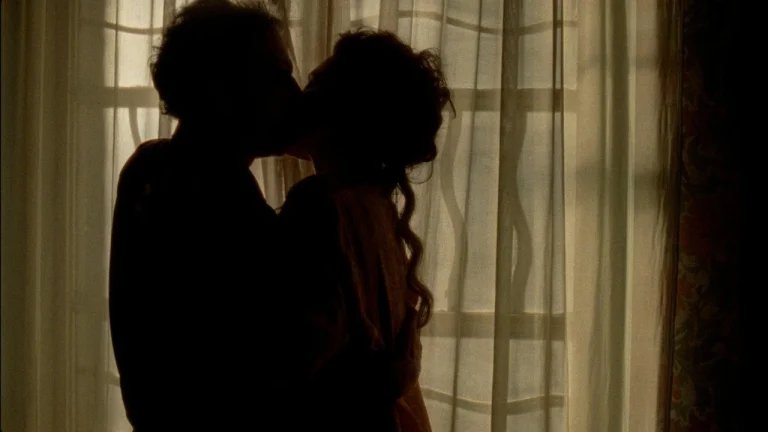Winner of the Short Film Palme d’Or Award in the 1986 Cannes Film Festival, Jane Campion turned out to be the first woman ever to win the category for her short film An Exercise In Discipline – Peel (1986). The story begins with the caution, “A true family/ A true story.” Encapsulating the idea of a consanguineal family structure, this film adheres to the self-made bonds of hierarchy, control, regulation, and penalization in an unprecedented reversal of roles. The reverberation of deviance and damnation is succinctly framed throughout the film, positioning the family members in a locative tension with each other.
While returning from a weekend road trip through the highway, the sister complains about the delayed homecoming, almost conforming to the curse of endless pestering and complaint. Her words are staunch, direct, pervasive, and selfish. The Sun augments the Western landscape of arid distance, a mirage of shrewd emotions repressed under the guise of unity. She repeats in monotony – “It was a scrappy bit of land.”
Immediately after the first sequence, a young lad is seen throwing a peel out of the window. He is instructed recurrently about the consequences by the father, but the reciprocation is honorary and masculine. The boy stifles the hole of the orange, a finger that probes into a flesh of desire and transcendence. The father cries, “Out!” and the close-up of a peel strikes the audience with the immediacy of the crime. The boy is asked to pick up every piece of peel, after which they would go back. The correlative history between the disciplining body and the knowledge system consisting of power relations makes the punishment a presupposed exercise.
As Michel Foucault claimed, “Visibility is a trap.” Even though it claims to be invisible, disciplinary power oversees an imposition of visibility. How? By assuring that the subjects must be constantly seen and by maintaining the subjection of the individual through an act of objectification. The mechanism of domination and examination is established through this dynamic opposition between the manifestation of potency and its direct attack on the child’s autonomy.
The next scene shows the woman openly urinating in the nearby fields, juxtaposing it with the irony of somatosensory bondage. She persistently reruns her laments, and she represents a yearning for her customary decorum, an attention that is specifically directed towards her sustained and replicating life.
“You said five. I asked you twice”.
“I would never have come if I knew we would be later than five.”
“This will be the first time I have missed Countdown in two years.”

The neurobiological, neuropsychological, and social hypothesis of conduct – all fall under the aegis of conventionally aggressive tactics of ‘greater’ genetic traits. The intergenerational patriarchy in Jane Campion is not extensively subtle. Instead, the complicity is undermined by the tonality of sounds, its irritable silence, and a historically restricted sexuality. In search of the boy, the father comes out of the car. He takes out the keys even though the woman is inside. The undue imbalance of continual distrust emphasizes a scenario of ‘outrageous morality.’
Resembling the aberration of ‘Wuthering Heights,’ Jane Campion approves a circumstantial revision of all Victorian standards of subjugation. The feminist project experiences the heat of the gender wars through a divisive and ‘factitious determination to be her own master.’ As the son gathers the ‘missing pieces’ of the peels, a coming-together camaraderie is inadvertently created between the father-son duo.
At the same time, the mother is seen disrupting the alliance by enabling a solemn wreckage of the nexus by peeling away the orange. The phenomenon mutually gratifies the sense of coalition and groupism between families, often with undulating terrains of discipline and punishment. The son and the father keep chanting, ‘Pick it up.’ The shadow becomes a fiend.
The imprisonment of the hiatus is significant as the disintegration pervades through the kinesis of an unpremeditated act. Corinn Columpar, in “The Gaze As A Theoretical Touchstone,” writes that the ideological presumptions of a theoretical assumption are complemented with analytical efficacy through multiple instrumental ‘signifieds.’ As posited by Gilles Deleuze, “A theory is exactly like a box of tools. It must be useful. It must function. And not for itself”.
The last part of the film shows the boy staring into the eyes of the mother, a close-up that cuts through any plausible reaction. It passes onto a mute stasis. On the other hand, the father is portrayed as ‘the face,’ a sustained engagement with the question of gendered engagements with the act of looking, or simply, ‘the gaze.’ E. Ann Kaplan rightly asserts, ‘Looking relations are never innocent.’ The trope is graphically presented as if surveying the legacies of American and European film history, a film (a gaze) not as a window onto the world but as its own signifying system with representational constraints and political baggage.
Objects of sight in cinema are entrenched with modernity that Rey Chow thinks is ‘specifically grounded in visuality.’ Laura Mulvey, in her seminal essay “Visual Pleasure and Narrative Cinema” (1975), showcases cinema’s complicity with unconscious pleasures of the male world and the invested sexual division of labor, wherein ‘men act, and women appear’ (Berger). Freud initially labels these as ‘conventions’ but essentializes these tendencies with the petition of ‘biology’ and ‘nature.’ This film’s libidinous drives and male aggression rely upon a slippage of agency. It dissolves the paradigm of a logical response to an appropriate problem and transforms the question of the perfect form of punishment.
Campion tries to foreground the Routine Activity Theory, where the prediction of criminal acts primarily entails: a) a motivated offender, b)a suitable target or victim c) the absence of a capable guardian (Felson & Cohen). In this case, social learning is based on a background-situational model, a typology that expands with the number of instances and offenders. Campion explicitly highlights that sexualization is profoundly heterosexual and heteronormative. The simple act of throwing away a peel of orange becomes a dilemma for the child and the mother, the former devoid of limitless possibilities and the latter reinforcing her prowess and careless attitude towards reality.
Similarly, the gaze doesn’t solely reveal the look of the subject at the object, but an instance when the object stares back. The gaze involves the spectator who is all-perceiving and all-perceived, a look back at his own deeds. The film ends with the boy jumping on the car’s hood while the prodigal parents stand poles apart.


![Mahaan [2022] ‘Prime Video’ Review – Calling It ‘Ridiculous’ is an Understatement](https://79468c92.delivery.rocketcdn.me/wp-content/uploads/2022/02/Mahaan-2022-768x432.jpg)
![Nirmal Pathak Ki Ghar Wapsi [2022] Review: The Tale of a Man’s Homecoming Is Shoddy & Pretentious](https://79468c92.delivery.rocketcdn.me/wp-content/uploads/2022/06/nirmal-pathak-ki-ghar-wapsi-768x427.jpg)



